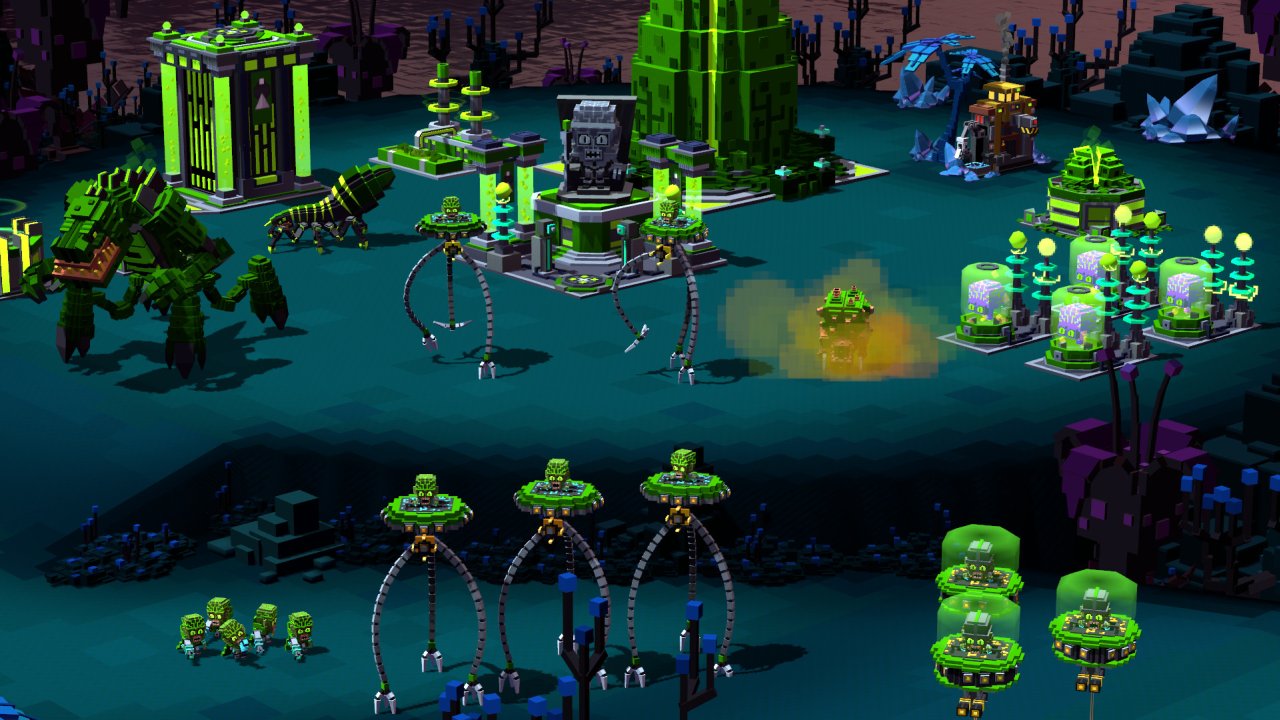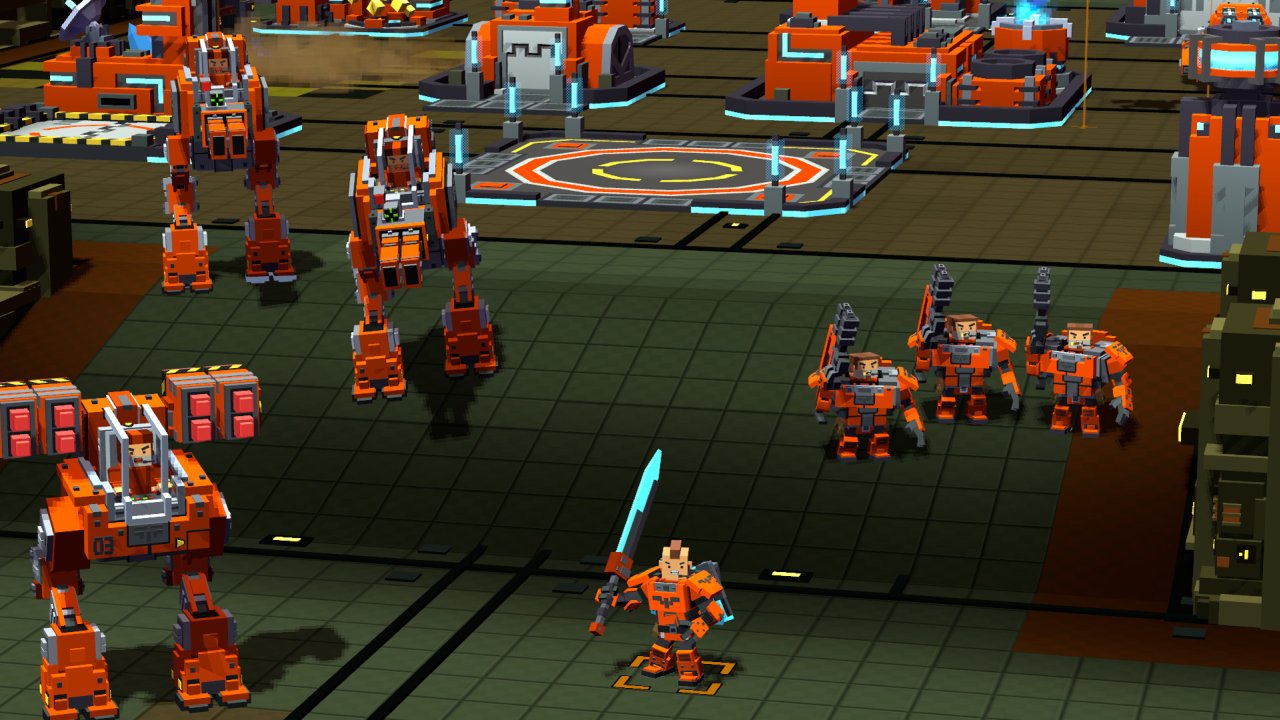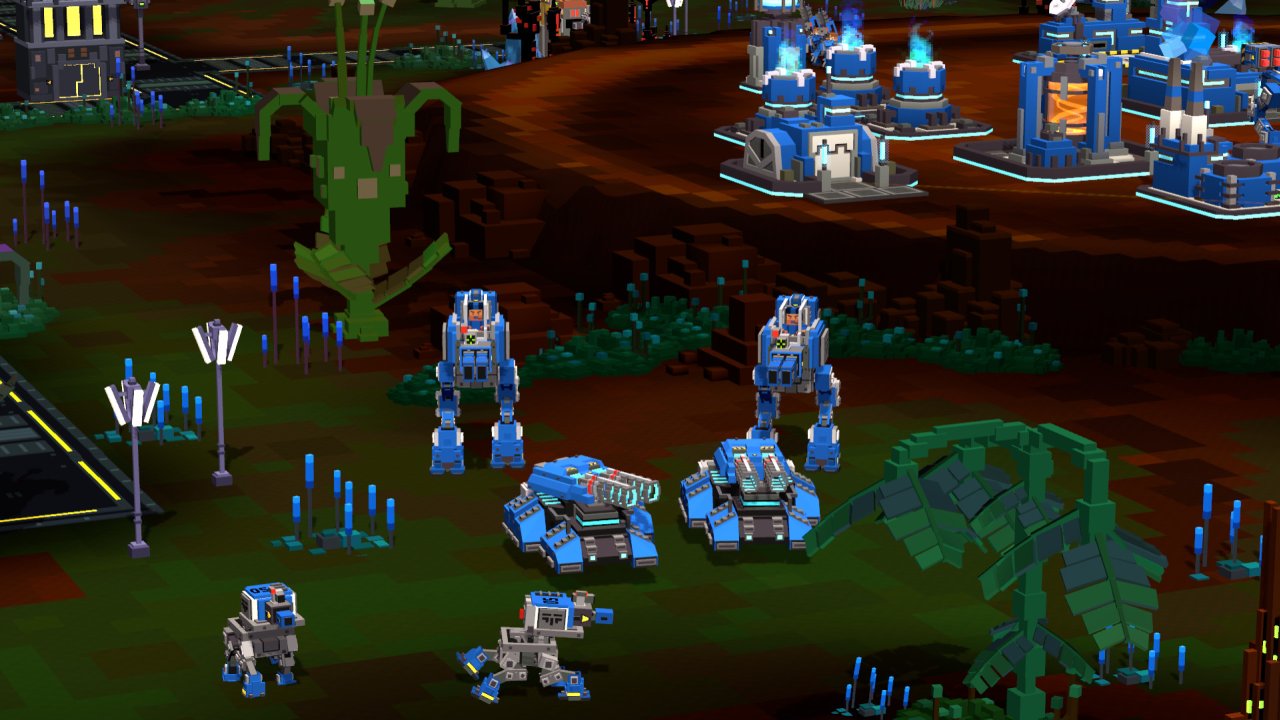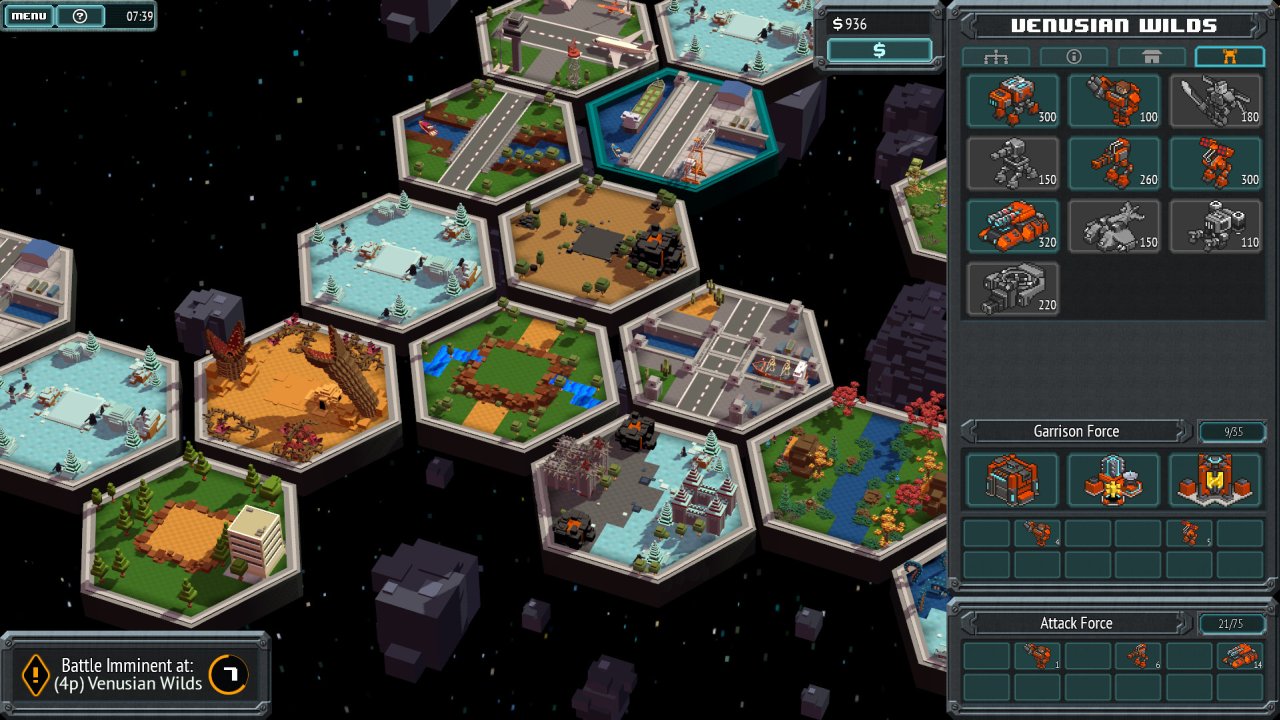8-Bit Invaders Review
Stargrafted
In the world of game development, it's not often that one feels compelled to cheer on the studios pushing out too-similar-to-be-coincidental knockoffs of successful franchises. There's something about the sheer patronising, bare-faced audaciousness of a blatant Minecraft or Counter-Strike clone that really puts a cockroach in my cornflakes. Who d'you think you are? How stupid do you think we are? How dare you waste precious time and energy crafting a cruel bastardisation of a creative work with no purpose other than to prey on the terminally ignorant? Take your banner ad and get out of my bloody sight.

And yet, Petroglyph's 8-Bit series of RTSes, which already contains less-than-subtle tributes to Command & Conquer and Warcraft, is a wholly different story. Yes, you could play the originals, but even if you can still get them working—an achievement that's never guaranteed in the world of retro PC gaming—many of them come from a bygone age when ‘usability' just didn't appear in designers' lexicons. 8-Bit Armies distinguished itself with polished old-school gameplay presented in a nonthreatening, colourful shell—earning the honourable accolade of ‘First RTS That David Legitimately Enjoyed Himself With' in the process—and with 8-Bit Invaders, Petroglyph have taken it upon themselves to apply that philosophy to everybody's favourite Zerg rushing simulator.
Yep, it's definitely-not-Starcraft. In one corner are the not-Terrans, defined chiefly by being the obligatory humans in the room—because of course, there's no way we're going to pass up a chance to have a war in space—in another corner are the Cranioids, a sort of technologically-advanced amalgam of the Zerg's monstrosities and the brainy green extras from the Mars Attacks set, and in the final corner we'll find the glaring absence of the Protoss, who were too snooty to show up. Good riddance. Both sides get their own little campaigns, though neither is much more than a sequence of flimsily-justified scenarios to gradually introduce the full spectrum of buildings and units. As with previous entries in the series, 8-Bit Invaders is a game to play with pals.
With any luck, it won't be too hard to scrounge some up; 8-Bit Invaders follows in the footsteps of its predecessors by staying simple, accessible, and about as intimidating as a beagle with a gammy leg. Tech trees can be parsed in a glance, active abilities don't exist, resource gatherers will stay focused on deposits until they're completely spent, and every unit tooltip will tell you exactly what it does, what it's most effective against, the type of damage it inflicts, and a score representing how many times you can hear its voice lines before you want to bore out your ear canals with a biro. It shows a welcome degree of awareness, especially for a so-called ‘retro' RTS that could easily have been exceedingly unpleasant to newcomers in the name of authenticity. That having been said, it still feels like Petroglyph's tutorials leave the job of bringing hapless newbies up to speed unfinished: they'll tell you how to make units, move the camera, right-click your way over to the enemy base and experience a patronising victory fanfare, but relatively basic things like attack-moving, balancing your economy or selecting specific subsets of units are conspicuously absent. I'd hate to think what kind of experience an actual fresh-faced RTS baby would have of the first few missions.

There's more to retro sensibilities than staying lean and mean, unfortunately. For the most part 8-Bit Invaders keeps to the series' high standard of polish, but somewhere along the line the unit AI got clobbered by a welding mallet and took a distinct turn for the daft. One of the basic Cranioid units—a fast, hunched-over dog-thing that probably had a much more distinctly-shaped head before Ridley Scott's lawyers came a-knocking—bursts into a pool of deadly acid upon death, rapidly damaging anything that treads in it. Fine, great, but when I'm attack-moving a squad across the map, I think it's pretty clear that I'd rather they didn't goose-step their way through the corrosive remains of the aliens they'd just slaughtered and lose five marines in the process. If I tell a gaggle of units to attack a foe, why does the floating medical drone—a unit which, incidentally, has taken a vow of pacifism and has zero offensive capability—immediately fly into melee range and get itself blasted to smithereens? Why do units fresh out of the barracks—or whatever the extraterrestrial equivalent is—need to be explicitly told to shoot back when attacked? Is self-defence not covered at some point at Space Marine Elementary School? Making your RTS units utterly incapable of thinking for themselves on a basic level raises the skill cap, perhaps, but only in the sense that I have to balance my commanding duties with chasing down hopeless minions, like a harried mother trying to stop her kids sampling the contents of the laundry cabinet. That's not strategy. That's busywork.
Another one of the holdovers from the earlier 8-Bit RTSes is the inclusion of crates; little presents scattered around the map at predetermined points by the same mysterious gang of workers that goes around spray-painting ‘A' and ‘B' on Counter-Strike bomb sites. Touching a crate with an infantry soldier yields a reward for your team—a handful of instant units, or perhaps just some bonus resources—and in the single-player missions they often get used as side-objectives, guarded by smaller squadrons of enemy units who for some reason haven't felt the need to peek inside. Conceptually they're a nice idea, rewarding early map scouting and aggressive mobile squads over just steamrolling everything with one giant disorganised mob, but I'm not sure they really work in practice all that well. The point at which they'd be most effective—those fragile early stages of the game when all your team has is a scrappy treehouse and half a dozen knock-kneed nerds in power armour—is also the point where overextending is riskiest, and not knowing whether you'll get a couple of flat-packed mechs or a few crumpled five-dollar notes really makes the risk too reliant on the whims of the dice roll.
If you've played any of Invaders' predecessors, you've probably already noticed an unmistakeably familiar scent hanging around it, and it just so happens that Petroglyph has a very valid excuse. All the 8-Bit RTSes run on the same engine and have more or less the same basic mechanics, and while you could certainly take that as a sign of stifling innovation, it does facilitate the games' crossplay feature, which lets you pitch any factions against each other so long as you own the games they're sourced from. While one could very well point out that this has the potential to turn into a perpetual balancing nightmare—how many factions can you add to the pile before the mere sight of your spreadsheets leaves men gibbering and dogs howling?—the spectacle of zapping a legion of terrified pikemen into oblivion with a flying saucer is well worth the risk. It also feels particularly mindful of just how difficult it can be to convince your friends to join you for a new multiplayer experience that hasn't already flooded every variety YouTube channel in existence; so long as they own at least one game in the series, you can still play together, even if it's just so you can stomp all over their archers with your space marines' big carbon-alloy boots.

Why not play with strangers, you ask? There are a multitude of ways to answer that question, but most importantly, despite the community's lively map design output and the reasonably well-outfitted multiplayer menus (seriously, a LAN option in this day and age?) the number of lobbies actually available hovers somewhere around ‘literally nothing'. It's not exactly a surprising state to find a smallish multiplayer game in less than a month after release—unless the developers are lucky enough to be visited by the Viral Fairy—but it does mean that you can't just leap in and find somebody equally clueless to smash armies with.
And that's sort of a shame, because 8-Bit Invaders really is tossing a lot of its eggs in the multiplayer basket. Quite apart from the standard skirmish and co-op campaigns, it also comes with an intriguing menu option labelled ‘Multiverse mode', which seems to be Petroglyph's latest attempt at squeezing the most out of its crossplay feature by kludging together a sort of meta-mode built around it. Through some calamity of astrophysics, a series of disparate battlefields from every game in the series have collided on a hexagonal grid suspended in the boundless void, facilitating a multi-level war where every conflict has lasting consequences. The idea is that you build up groups of units in hexes that you own and then move their abstract representations around on the board, with the ultimate goal of stepping over to the other player's base and kicking the door off its hinges. Moving into a hex that you don't own will trigger a battle between you, the locals, an army belonging to the other player, or some combination thereof, and the results of the battle will determine who gets to own the hex, as well as whose army is getting sent home in a breadbox.
As framing devices for battles go, it's not a half-bad attempt, and I can certainly see myself indulging in a game of it with a friend if we fancied spending an hour or two on a lengthy back-and-forth, but the join between the two levels of strategy is a little bit shaky and held together with masking tape. Before each battle you're given an estimation of your odds of success and the option to let the game simulate the battle for you, so you don't need to go through the whole song and dance when the full might of the Cranioid menace rolls into a hex containing four terrified peasants and a rotting trebuchet. It's very nearly a brilliant feature, but the calculations are so unreliable that you might as well just run through every battle that's not a 100% guaranteed success anyway. Several times within the course of a single match I ended up steamrolling through battles that the computer had already told me were literally impossible to win, which could've maybe been sort of validating if it wasn't such a tremendous waste of time. And why does the game set up its battles so poorly? Multiple times I found myself deposited so close to the opponent that we could see each other's armies from the moment the loading screen disappeared, a setup that would've ensured complete disaster if the AI wasn't passive enough to grant me breathing room.

Unsurprisingly, what 8-Bit Invaders ultimately offers is largely the same as its predecessors: a streamlined, accessible, reasonably polished RTS with familiar thematic and gameplay roots. Yeah, without an abundance of fresh ideas or distinct character of its own, it's a derivative experience at best, but it's a remarkably solid derivative experience that strips away the cruft from that which it was derived from, and sometimes—like, say, when most of the authentic examples of the formula are now well past their use-by date—that's a welcome thing. It's not particularly deep or fresh, even by the standards of its own franchise, but if you're just looking for some old-school real-time strategy with laser guns and spaceships a-plenty, maybe 8-Bit Invaders is right for you.
 Comments
Comments













